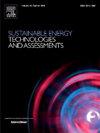Optimizing power and energy loss reduction in distribution systems with RDGs, DSVCs and EVCS under different weather scenarios
IF 7.1
2区 工程技术
Q1 ENERGY & FUELS
Sustainable Energy Technologies and Assessments
Pub Date : 2025-01-31
DOI:10.1016/j.seta.2025.104219
引用次数: 0
Abstract
Electric power grids are increasingly vulnerable to disruptions from extreme weather events, resulting in prolonged outages. The rise of electric vehicles (EVs) offers benefits like improved sustainability and reduced maintenance but also introduces challenges such as voltage instability and higher power losses when integrated into radial distribution systems (RDS). This study proposes an approach that integrates electric vehicle charging stations (EVCSs), distribution static VAR compensators (DSVCs), and renewable energy sources (RESs) like solar and wind into RDS, supporting both grid-to-vehicle (G2V) and vehicle-to-grid (V2G) modes to enhance flexibility and resilience. The study aims to reduce power losses under normal conditions and minimize energy not delivered (END) during fault conditions, evaluated under different weather scenarios. The spotted hyena optimizer algorithm (SHOA) and genetic algorithm (GA) are employed to optimize RDG, DSVC, and EVCS locations and capacities. Tests on the IEEE 34-bus RDS show SHOA achieves a 25 % reduction in power losses, improving system resilience and outperforming GA in both power and energy loss reduction.
求助全文
约1分钟内获得全文
求助全文
来源期刊

Sustainable Energy Technologies and Assessments
Energy-Renewable Energy, Sustainability and the Environment
CiteScore
12.70
自引率
12.50%
发文量
1091
期刊介绍:
Encouraging a transition to a sustainable energy future is imperative for our world. Technologies that enable this shift in various sectors like transportation, heating, and power systems are of utmost importance. Sustainable Energy Technologies and Assessments welcomes papers focusing on a range of aspects and levels of technological advancements in energy generation and utilization. The aim is to reduce the negative environmental impact associated with energy production and consumption, spanning from laboratory experiments to real-world applications in the commercial sector.
 求助内容:
求助内容: 应助结果提醒方式:
应助结果提醒方式:


